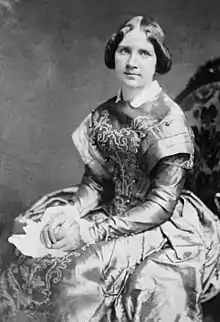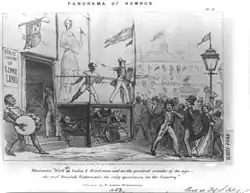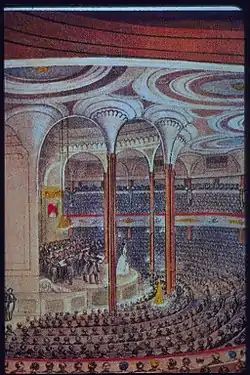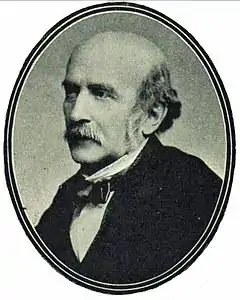Jenny Lind tour of America, 1850–52
The Swedish soprano Jenny Lind, often known as the "Swedish Nightingale", was one of the most highly regarded singers of the 19th century. At the height of her fame she was persuaded by the showman P. T. Barnum to undertake a long tour of the United States. The tour began in September 1850 and continued to May 1852. Barnum's advance publicity made Lind a celebrity even before she arrived in the U.S., and tickets for her first concerts were in such demand that Barnum sold them by auction. The tour provoked a popular furore dubbed "Lind Mania" by the local press, and raised large sums of money for both Lind and Barnum. Lind donated her profits to her favoured charities, principally the endowment of free schools in her native Sweden.

Lind's concerts featured a supporting baritone, Giovanni Belletti, and her London colleague Julius Benedict as pianist, arranger and conductor. Lind found Barnum's relentless commercial promotion of her increasingly distasteful, and she terminated her contract with him in 1851 under amicable circumstances, continuing to tour for nearly a year under her own management. Benedict returned to England in 1851, and Lind's friend Otto Goldschmidt joined the tour as her pianist and conductor. She and Goldschmidt married in February 1852.
Background
Lind was born in 1820 and enrolled at the Swedish Royal Dramatic Theatre's acting school at age ten. In 1838, she gained fame for her performance at the Royal Swedish Opera as Agathe in Der Freischütz.[1] After this, she was in great demand throughout Sweden and the rest of Europe for a decade.[2] By 1849, when Lind was in the middle of her third triumphant London season, the American showman P. T. Barnum had become aware of her success and the large audiences she attracted. He had toured Europe in 1845 and 1846 with his first great attraction, General Tom Thumb. He had never heard Lind sing, and was by his own admission unmusical,[3] but he knew that concert halls sold out wherever she performed. Furthermore, he was confident that her reputation for philanthropy could be turned to good use in his publicity.[3] In October 1849, he engaged an Englishman, John Wilton, to locate Lind and make her an offer.
Lind wanted to endow free schools in Sweden, and Barnum's offer would allow her to earn a great deal of money.[4] After checking Barnum's credit with a London bank, on 9 January 1850, Lind accepted his offer of $1,000 a night (plus expenses) for up to 150 concerts in the United States. She insisted on the services of Julius Benedict, a German conductor, composer and pianist with whom she had worked in England, and of the Italian baritone Giovanni Belletti as assisting artist, since solo recitals were still unknown to American audiences. Benedict's fee was $25,000 and Belletti's $12,500. All told, Barnum had committed to $187,500 (approximately $5,762,000 today) to bring Lind and her musical troupe to America.

Lind's contract called for the total fee to be deposited in advance with the London banking house of Baring Brothers. Barnum had not anticipated front-end payments for Lind, since he always had paid performers as performances were completed. To raise the money, Barnum sought loans from New York bankers, who refused to make the loans based on a percentage of the Lind tour, so Barnum mortgaged all his commercial and residential properties. Still slightly short, Barnum finally persuaded a Philadelphia minister, who thought that Lind would be a good influence on American morals, to lend him the final $5,000. Barnum sent the $187,500 to London. Lind signed the contract to give 150 concerts in a year or eighteen months, with the option of withdrawing from the tour after sixty or one hundred contracts, paying Barnum $25,000 if she did so.[4]
Few Americans had ever heard of Lind, and Barnum's first press release set the tone of the promotion. "A visit from such a woman who regards her artistic powers as a gift from Heaven and who helps the afflicted and distressed will be a blessing to America." Her biographical pamphlet and photograph proclaimed: "It is her intrinsic worth of heart and delicacy of mind that produces Jenny's vocal potency." Barnum heavily promoted her record of giving frequent benefit concerts for hospitals and orphanages. Before Lind had even left England, Barnum had made her a household name in America. In a statement to the New York Herald, Barnum spoke of the huge sums he had committed, but assured the paper, "If I knew I should not raise a farthing profit I would yet ratify the engagement, so anxious I am that the United States should be visited by a lady whose vocal powers have never been approached by any other human being, and whose character is charity, simplicity and goodness personified."[5]

In August 1850, before Lind left England, sailing from Liverpool on the paddle steamer Atlantic, Barnum arranged for her to give two farewell concerts at the city's Philharmonic Hall. Of her arrival in Liverpool, The Observer wrote that her reception "was equal to any ever experienced by the most illustrious or royal visitor. Each day a crowd gathered round her hotel, the Britannia Adelphi, and followed the carriage wherever it went."[6] The first concert was a performance of Messiah conducted by Benedict, the second a mixed recital with serious and light items. She was, according to an eye-witness, "literally 'bombarded' with bouquets. She could scarcely make her way out of the orchestra, there was such a heap of flowers in all possible shapes."[7] On the day of her embarkation she was cheered off by thousands of well-wishers on both banks of the River Mersey, and salutes were fired from the shore.[7] A critic engaged by Barnum to cover the concert wrote of the enthusiasm of the Liverpool public and its grief at Lind's imminent departure. This review was widely circulated in English, European and American newspapers a week before Lind arrived in New York. During the voyage she and Benedict gave two concerts for the passengers and crew of the Atlantic.[8] In her travelling party, with Benedict and Belletti, were her companion, Miss Alimanzioni, and her secretary, Max Hjortsberg.[9]
Arrival in New York City
The Atlantic docked in New York on 1 September 1850. The following day, The New York Herald reported on "the spectacle of some thirty or forty thousand persons congregated on all the adjacent piers. ... From all quarters, crowds ... could be seen hurrying down towards the Atlantic's dock." So great was people's desire for a glimpse of the star that several people were "severely bruised, some came off with bloody noses, and two boys, about twelve years of age, appeared to be seriously injured. Had not the rush been checked in time, many lives would have been lost."[10] When she set foot on American soil, Lind kissed her hand to the U.S. flag and exclaimed, "There is the beautiful standard of freedom, which is worshipped by the oppressed of all nations."[8] She further endeared herself to the welcoming crowd by stopping Barnum's coachman from clearing a path through the throng with his whip.[8]

When she realised how much money Barnum stood to make from the tour, Lind insisted on renegotiating their contract.[10] The new agreement, signed on 3 September 1850, gave her the original $1,000 per concert agreed to, plus the remainder of each concert's profits after Barnum's $5,500 concert management fee was paid. Her interest in increasing her earnings was, it seems, genuinely motivated by her determination to accumulate as much money as possible for her chosen charities,[2][3] but some commentators were sceptical; one wrote:
I'm a famous Cantatrice, and my name it is Miss Jenny,
And I've come to these United States to turn an honest penny.
To which Barnum is depicted as responding:

Such dissenting voices were in a minority. Lind's appeal in America was, as Barnum had calculated, due as much to her simple and virtuous personality and her generosity to good causes as to her singing. Barnum is quoted as saying "[I]t is a mistake to say the fame of Jenny Lind rests solely on her ability to sing. She was a woman who would have been adored if she had had the voice of a crow."[10]
Lind's first two American performances were given as charity concerts in New York City on 11 and 13 September 1850 at Castle Garden, now better known as Castle Clinton. The seats for the first were sold at auction two days beforehand; 4,476 tickets were sold at a total price of $24,753,[12] with the theatre "packed to its utmost capacity".[9] The program for the concert states that the orchestra accompanying Lind consisted of 60 players.[13] Lind's numbers that evening were "Casta diva" from Norma; a duet with baritone, "Per piacee alla Signora", from "Il turco in Italia"; a trio for two flutes and voice, to the "echo song" "Dost thou hear?", composed for Lind by Meyerbeer, from The Camp of Silesia, sung in English, "in which she performed some astonishing vocal feats that bordered on ventriloquism", and some Swedish songs.[3][14] These were regular items in her tour programs, but on this occasion they were joined by a "Greeting to America", a song with words by the local poet, Bayard Taylor, set to music by Benedict.[3] After Lind had left the platform, to tumultuous applause, Barnum took the stage and, although she had asked him not to do so, told the audience that she was taking no fee for herself and donating her entire fee of $10,000 to twelve New York charities. A reporter commented, "The deafening shouts that followed the ... speech were absolutely indescribable – many, even among the male portion of the audience, weeping with emotion."[15]
The blatant commercialism of Barnum's ticket auctions distressed Lind,[10] and for the second concert and thereafter she persuaded him to make a substantial number of tickets available at two dollars for the cheapest seats and one dollar for the promenade.[15]
Touring
Under the management of Barnum, whose publicity always preceded her and whipped up enthusiasm (he had up to 26 journalists on his payroll),[16] Lind and her company toured first in the eastern United States in her own private railroad car, with concerts in Boston, Philadelphia, Washington, D.C. and Richmond, Virginia.[16] Barnum marketed various Jenny Lind-branded products, including songs, clothes, chairs and pianos.[17]
From there they went by ship to Charleston, South Carolina, a short but perilous voyage during which they came close to being sunk by a storm; the ship was at one point reported lost.[18] From Charleston, the company went to Havana, but Lind was less successful there; the local public wanted to see her in opera rather than in concert, and the ticket prices were too high for the general public.[9][19] From Cuba the party sailed to New Orleans, where Lind was greeted with rapturous enthusiasm.[20] The historian Keith Hambrick has published a study of Lind's time in the city, which includes details of the commercial marketing of her image, unauthorised and of no monetary reward to her, such as Jenny Lind shirts, Jenny Lind cravats, Jenny Lind gloves, Jenny Lind pocket handkerchiefs, Jenny Lind coats, Jenny Lind hats, and even Jenny Lind sausages.[20] Tickets for all of her 13 concerts in New Orleans were so much in demand that a charge was made for admission to the auction for tickets.[21] Hambrick quotes details of the programming of some of the concerts:
The concert began at eight o'clock with selections by the orchestra. The thirty-five musicians, conducted by Julius Benedict and including the distinguished violinist Joseph Burke, played two grand overtures from Auber's opera, Masaniello, and then later in the concert, the famous "Wedding March" from Mendelssohn's celebrated incidental music to A Midsummer Night's Dream. One resident, in complimenting the orchestra, said that he had never heard a group with better balance and that the proportion of instruments was admirable.[20]
Belletti came on before Lind, and after his own numbers he went offstage and escorted her to the platform. She would sing five or so numbers during the course of the concert: on one occasion in New Orleans these were "Come per me sereno", from Bellini's La sonnambula; a buffo duet with Belletti ("Per piacer alla Signora") from Rossini's Il turco in Italia; her trademark trio for voice and two flutes composed for her by Meyerbeer; and to finish the concert, a Swedish song, the "Herdsman's Song", sung in her native language. At other concerts, Belletti sang "Largo al factotum" from The Barber of Seville and Lind sang "Casta diva" from Norma and "I know that my Redeemer liveth" from Messiah.[20]
From New Orleans, the party sailed up river to Natchez, Mississippi, Memphis, Tennessee, and St. Louis, Missouri.[16] After this, they performed at Nashville, Tennessee, where a critic wrote:
The extreme burst of her voice in the upper portion of its register is far beyond the ordinary range of sopranos, and she has acquired the power of moulding the higher notes entirely at her will. By this she is enabled to produce some of the most astonishing effects upon the listener. ... Another of the more special beauties which particularly mark the voice of Mlle Lind is the unexampled quality and delicacy of its piano. ... The transition from the high to the low notes is rapidly effected and seems as though it cost her no effort.[22]
The last stops in the Barnum tour were Louisville, Kentucky, Cincinnati, Ohio, and Pittsburgh, Pennsylvania, where the crowds were so unruly that Lind was trapped in the concert hall for a short time.[16] Stones were thrown at her carriage and into her dressing room,[23] and Barnum hastily rearranged the tour schedule. After a detour to New York, the company returned to Philadelphia.[16] There, Lind and Barnum parted company on 9 June 1851.[24] The separation was amicable, and they remained on good terms afterwards, but Lind had wearied of Barnum's assertive marketing of her. For the rest of her American tour she was her own impresario. She extended her itinerary to include Canada, giving a concert in Toronto for which tickets sold out within 90 minutes of going on sale.[25]
In July 1851, the 20-year-old American poet Emily Dickinson gave an account of a Lind concert:

... how bouquets fell in showers, and the roof was rent with applause – how it thundered outside, and inside with the thunder of God and of men – judge ye which was the loudest; how we all loved Jennie Lind, but not accustomed oft to her manner of singing didn't fancy that so well as we did her. No doubt it was very fine, but take some notes from her Echo, the bird sounds from the Bird Song, and some of her curious trills, and I'd rather have a Yankee. Herself and not her music was what we seemed to love – she has an air of exile in her mild blue eyes, and a something sweet and touching in her native accent which charms her many friends. ... as she sang she grew so earnest she seemed half lost in song. ... She took $4,000 for tickets at Northampton aside from all expenses.[26]
At about the same time, Benedict received an offer from London to take over as musical director at Her Majesty's Theatre. He accepted, and to replace him, Lind invited Otto Goldschmidt, whom she had known for many years.[4] He was nine years her junior, but they formed a close attachment and were married quietly in Boston on 5 February 1852, shortly after he had been baptised an Episcopalian out of consideration for Lind's religious views.[2]
The tour finally returned to New York in May 1852. The New York Times reported, "Madame Goldschmidt's Farewell Concert, last evening, was attended by the largest and finest audience we ever saw assembled in New-York. The vast area of Castle Garden was crowded to its utmost capacity, and thousands thronged the passage ways – the covered bridge leading from the Garden to the Battery, and the walks into the street far beyond the outer gates."[27] Her best known numbers were joined on this occasion by a new song "Farewell to America", with words by C.P. Cranch and music by Goldschmidt.[27] On 29 May 1852, Lind, Goldschmidt and the party sailed from New York back to England.[28]
Legacy
Charities
Lind gave 93 concerts in the United States for Barnum, earning her about $350,000; Barnum netted at least $500,000.[29] From the outset, Lind had determined to give all her fees to charity. Her principal beneficiaries were free schools in her native Sweden, but she also distributed her U.S. concert earnings to local charities, including $1,000 to help build a church in Chicago, and $1,500 for the "mother church" of the Lutheran Augustana Synod in Andover, Illinois.[30][31]
In September 1850, Lind gave $5,000 (approximately $154,000 today) to her Swedish friend, Poly Von Schneidau, for a new camera for his Chicago studio, later used to create one of the earliest images of Abraham Lincoln. On 14 September 1850, Von Schneidau took the first American daguerreotype of Lind at the New York Mathew Brady Studio.[32][33][34] His photo of Lind is in the Library of Congress Collection.[35]
Memorials
Lind visited Mammoth Cave in central Kentucky in 1851. A feature in the cave was named in her honour, variously described as "Jenny Lind's Armchair" or "Jenny Lind's Table."[36] The community of Jenny Lind, California, was likely named after her, although she did not visit the state during the tour.[37] Cottage-style spindled furniture is still named for her, especially Jenny Lind cribs and beds.[38] The tour is a plot point in the 1980 musical Barnum and the 2017 film The Greatest Showman, both of which include a fictionalized relationship between Lind and Barnum with "romantic undertones".[39]
Notes
- Lindgren, A. "Lind-Goldschmidt, Jenny Maria" in Westrin, Th: Nordisk familjebok, Nordisk familjeboks förlags aktiebolag, 1912, Vol. 16, pp. 614–17, accessed 16 June 2011 (in Swedish)
- Rosen, Carole. "Lind, Jenny (1820–1887)", Oxford Dictionary of National Biography, Oxford University Press, 2004, accessed 16 June 2011
- Rogers, Francis. "Jenny Lind", The Musical Quarterly, Vol. 32, No. 3 (July 1946), pp. 437–448 (subscription required)
- Miller, Philip L. "Review: P. T. Barnum Presents Jenny Lind: The American Tour of the Swedish Nightingale", American Music, Spring 1983, pp. 78–80 (subscription required)
- "The Visit of Jenny Lind to America", The Times, 6 March 1850, p. 7
- "Jenny Lind at Liverpool", The Observer, 25 August 1850, p. 3
- "Jenny Lind's Departure for America", The Illustrated London News, 24 August 1850, pp. 171–172
- "United States", The Manchester Guardian, 18 September 1850, p. 2
- Obituary, The New York Times, 3 November 1887
- Linkon, Sherry Lee. "Reading Lind Mania: Print Culture and the Construction of Nineteenth-Century Audiences", Book History, Vol. 1 (1998), pp. 94–106 (subscription required)
- O'Connor, Patrick. "The Soprano on Show", The Times Literary Supplement, 20 February 1981 p. 202
- "United States", The Manchester Guardian, 25 September 1850, p. 2; Lind's program for the first concert states that sales would "considerably exceed $35,000". "Introduction", Castle Garden program, September 11, 1850
- "Introduction" (verso page), Castle Garden program, September 11, 1850
- "Part II", Castle Garden program, September 11, 1850
- "Jenny Lind's Progress in America", The Observer, 6 October 1850, p. 3
- Hambrick, Keith S. "P. T. Barnum Presents Jenny Lind – The American Tour of the Swedish Nightingale", Louisiana History: The Journal of the Louisiana Historical Association, Vol. 22, No. 2 (Spring, 1981), pp. 208–209 (subscription required)
- McNamara, Robert (August 31, 2018). "Jenny Lind, Who P.T. Barnum Made the Biggest Attraction in America". ThoughtCo.com. Retrieved April 15, 2019.
- "America", The Times, 7 January 1851, p. 5
- "Selling The Swedish Nightingale". americanheritage.com. Retrieved April 15, 2019.
- Hambrick, Keith S. "The Swedish Nightingale in New Orleans: Jenny Lind's Visit of 1851", Louisiana History: The Journal of the Louisiana Historical Association, Vol. 22, No. 4 (Autumn, 1981), pp. 387–417 (subscription required)
- The admission charge to the auction was a dime, and the proceeds were given to local charities. See Hambrick (Autumn 1981)
- The Daily American, Nashville, quoted in, O'Connor, Patrick. "The Soprano on Show", The Times Literary Supplement, 20 February 1981 p. 202
- "America", The Times, 13 May 1851, p. 5
- "America", The Times, 23 June 1851, p. 5
- "Jenny Lind in Canada", The New York Times, 21 October 1851
- Linscott, Robert N. (1959) Selected Poems and Letters of Emily Dickinson, Anchor Books, Random House, New York, p. 242
- "Jenny Lind's Farewell", The New York Times, 25 May 1852
- "America", The Times, 26 May 1852, p. 5
- "America", The Times, 28 June 1851, p. 5
- Historic Churches of the Augustana Evangelical Lutheran Church Archived 2015-11-21 at the Wayback Machine
- Jenny Lind Chapel, Andover, Illinois
- "Mademoiselle Jenny Lind", New York Herald, September 16, 1850
- Fredrika Bremer: America of the Fifties. OUP, 1924
- Beaumont Newhall: The Daguerreotype in America, 1976 (Google books)
- Von Schneidau, Poly. Jenny Lind image, Library of Congress call number DAG 509X, accessed May 28, 2019
- The Bransfords of Mammoth Cave (Mammoth Cave National Park bulletin)
- Koeppel, Elliot H. The California Gold Country: Highway 49 Revisited, Malakoff & Co.:La Habra, California, accessed May 29, 2013, ISBN 0-938121-12-X
- McBride, Carrie. "Will the Real Jenny Lind Please Stand Up?", ApartmentTherapy.com, 20 April 2011, accessed 11 June 2014
- Kellem, Betsy Golden. "The Greatest Showman: The True Story of P.T. Barnum and Jenny Lind", Vanity Fair, 22 December 2017